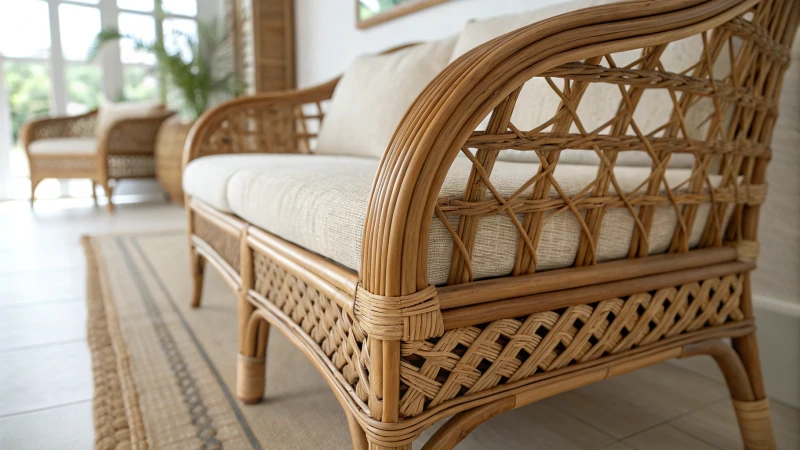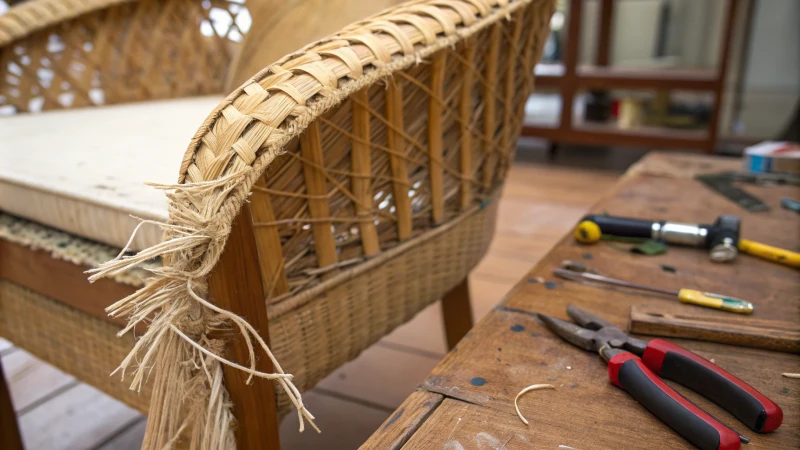
Ever sat down in your favorite rattan chair, only for it to sink under you? I understand – it’s really disappointing!
Preventing sagging in your rattan involves keeping its shape intact. Moisture rehydrates the material. Cushions add support. Regular checks for wear are important. Your furniture stays attractive. It also remains comfortable.
Keeping your rattan hydrated is essential to prevent sagging. A soft mist of water really helps, almost like giving your furniture a refreshing drink. Cushions add extra support. They also give a stylish touch. Regularly checking for signs of wear is a good habit. Small maintenance tasks are very effective in maintaining that beautiful look.
Moisture can help prevent rattan from sagging.True
Applying moisture to rattan furniture rehydrates the material, helping it maintain its shape and preventing sagging over time.
Adding cushions will not support sagging rattan.False
Using cushions provides additional support to rattan furniture, helping to alleviate sagging and enhance comfort.
What Causes Rattan Furniture to Sag?
Rattan furniture has a unique charm and strong design. Many homes treasure it. However, sagging sometimes happens after some time. Why does this annoying issue happen?
Rattan furniture sags mainly because of the environment, wrong use and the materials themselves. Humidity affects it a lot. So does how weight spreads across it.

Understanding the Material Properties of Rattan
Rattan is a natural material derived from climbing palms, known for its flexibility and strength. However, over time, factors such as humidity and weight can affect its structure.
Humidity plays a significant role in the sagging of rattan furniture. High moisture levels can cause the fibers to expand, leading to a loss of shape. I remember a very humid summer when my rattan chair sagged more than usual; the air’s moisture caused the fibers to swell, making it lose shape.
On the other hand, weight distribution is crucial. If furniture is overloaded or used improperly—like sitting too heavily on one side or putting too much stuff on it—it can lead to sagging in specific areas, compromising its overall integrity. It’s important to watch this when inviting friends over; extra snacks might really impact the furniture!
For more insights on maintaining your rattan furniture, check out this guide1.
Common Usage Mistakes
Many consumers unknowingly contribute to the sagging of their rattan furniture through common usage mistakes. Here are a few:
| Usage Mistake | Effect on Furniture |
|---|---|
| Overloading | Increases stress on joints |
| Sitting on edges | Causes misalignment |
| Using harsh chemicals | Weakens fibers |
I often made mistakes with my rattan furniture without realizing it! By changing these habits, I have managed to extend the life of my pieces. For detailed tips on proper usage, see this article2.
Environmental Factors
The environment where rattan furniture is placed can also influence its condition:
- Direct Sunlight: Prolonged exposure can dry out the material, making it brittle; I discovered this when my chair sat by a sunny window.
- Temperature Fluctuations: Sudden changes can cause the fibers to contract and expand, leading to weakness; I live where temperatures change from hot to cool.
These environmental factors are crucial to consider if you want to maintain your rattan furniture’s integrity. To learn more about optimizing your environment, visit this resource3.
Maintenance Tips to Prevent Sagging
Preventative maintenance is key to avoiding sagging in rattan furniture. Here are some effective strategies:
- Regular Cleaning: Dust and dirt can accumulate and weaken fibers over time; a good dusting helps a lot!
- Re-tightening Loose Joints: Periodic checks for any loose joints can prevent major sagging issues.
- Conditioning Products: Use suitable products designed for rattan to keep it hydrated; these products are very effective in keeping the material healthy.
For more maintenance tips, explore this comprehensive guide4.
Humidity can cause rattan furniture to lose its shape.True
High moisture levels expand rattan fibers, leading to sagging and loss of shape over time.
Sitting on the edges of rattan furniture prevents sagging.False
Sitting on edges increases misalignment, contributing to sagging rather than preventing it.
How Can I Restore the Shape of My Rattan?
Is your rattan furniture sagging or losing shape? I have some great tips to help you restore its beauty and usefulness. These pieces are special. Let’s bring them back to life!
If your rattan furniture sags, restore its shape by cleaning it. Lightly moisten the furniture. Gently reshape it. Allow it to dry completely. Lastly, apply a protective sealant. These steps will revitalize your pieces. Let’s explore this process in detail!

Step-by-Step Restoration Process
Restoring the shape of rattan furniture can often be done with simple home techniques. Here’s a practical guide:
-
Clean the Furniture: Start by removing any dirt or dust with a soft brush or cloth. You may need a mild soap solution for deeper cleaning.
-
Moisten the Rattan: Use a spray bottle filled with water to lightly mist the rattan. This will make it pliable for reshaping. Avoid soaking it completely.
-
Reshape Carefully: Gently pull and shape the rattan back to its original form. Be cautious not to apply too much pressure to avoid breaking it.
-
Drying: Allow the rattan to dry in its new shape. It’s best to place it in a well-ventilated area away from direct sunlight.
-
Finish with Protector: After it’s fully dried, consider applying a rattan-specific sealant to help protect against future deformation.
For more insights on restoration techniques, check out this restoration tutorial5.
Understanding Rattan Furniture Deformation
Rattan furniture can lose its shape over time due to various factors such as exposure to humidity, sun, and general wear and tear. Recognizing the causes of deformation is crucial for effective restoration.
For instance, humidity can cause rattan to swell, while excessive heat can lead to drying and cracking. To understand this better, consider the following table:
| Cause of Deformation | Effect on Rattan | Recommended Action |
|---|---|---|
| High Humidity | Swelling | Dry in a cool area |
| Direct Sunlight | Cracking | Use UV protectors |
| General Wear | Sagging | Regular maintenance |
By identifying these factors, you can take proactive measures to protect your rattan pieces and prolong their life.
Preventive Maintenance Tips
Maintaining your rattan furniture can prevent future shape loss. Here are some tips:
- Regular Dusting: Keeping your furniture free from dust and debris will help maintain its integrity.
- Avoid Excessive Moisture: Store rattan pieces in dry environments.
- Use Coasters: Protect surfaces from water rings and stains.
- Periodic Reshaping: Every few months, check the shape and reapply the above restoration techniques as necessary.
For more insights on preventive care, consider visiting this resource6.
Humidity causes rattan to swell and lose its shape.True
High humidity can lead to the swelling of rattan furniture, resulting in deformation that affects its structure and appearance.
Direct sunlight does not affect the condition of rattan furniture.False
Excessive exposure to direct sunlight can cause rattan to crack, negatively impacting its shape and durability.
How Can I Prevent My Rattan Furniture from Sagging?
Rattan furniture possesses a unique charm that brightens spaces. However, sagging often becomes a big concern for many owners. Preserving the beauty of rattan is important. Keeping our beloved rattan looking stunning really matters.
To keep rattan from drooping, focus on regular care, even weight placement and protection from the environment. These steps really lengthen the life and beauty of rattan furniture. Your investment is worthwhile! Let’s see how you do this well.

Here are some very practical tips that I have really learned on my journey!
Understanding Rattan Sagging
Rattan furniture is beloved for its natural beauty and versatility. However, sagging can occur due to various factors, including poor construction, exposure to moisture, and weight distribution.
To prevent sagging, it’s essential to understand the root causes. Regularly inspecting your rattan pieces for signs of wear and adjusting their placement can help maintain their shape. You can also learn about the most common causes of sagging7.
Regular Maintenance Tips
Maintaining rattan furniture involves more than just cleaning; it requires a proactive approach:
| Maintenance Task | Frequency | Benefits |
|---|---|---|
| Wipe with a damp cloth | Weekly | Removes dust and prevents dirt buildup |
| Apply a protective sealant | Every 6 months | Protects from moisture and UV damage |
| Store in a dry place | Year-round | Prevents mold and sagging due to humidity |
Regular care not only enhances durability but also helps in preserving the aesthetic appeal of your rattan products. For more insights on effective maintenance practices8.
Proper Weight Distribution
Another preventive measure is ensuring proper weight distribution when using your rattan furniture. Avoid placing heavy items on the edges of rattan chairs or tables, as this can lead to premature sagging.
Consider using lightweight alternatives or spreading the weight evenly. You might also want to explore tips on how to properly use your rattan furniture9 to avoid unnecessary strain.
Environmental Factors
Environmental conditions play a significant role in the longevity of rattan furniture. High humidity levels can lead to swelling and subsequent sagging, while excessive dryness can cause brittleness. To mitigate these issues:
- Keep Rattan Dry: Use dehumidifiers in humid environments.
- Avoid Direct Sunlight: Position rattan away from direct sunlight to prevent fading and cracking.
Learn more about how to protect your rattan from environmental damage10.
Restoration Techniques
If you notice sagging, consider restoration techniques such as reweaving or tightening loose strands. Engaging with professionals who specialize in rattan repairs can extend the life of your furniture significantly. For DIY enthusiasts, here are some restoration tips for rattan11 that you can try at home.
Regular maintenance prevents rattan furniture sagging.True
Consistent care, such as cleaning and applying sealants, helps maintain the shape and durability of rattan furniture, reducing the risk of sagging.
Humidity causes rattan to sag more than dryness.True
High humidity can lead to swelling in rattan, increasing the likelihood of sagging, while dryness causes brittleness, affecting longevity.
What Repair Options Are Available for Damaged Rattan?
Have you ever looked at your treasured rattan furniture and felt nostalgia from the many memories made around it? Maybe it appears worn and tired. Let’s discover ways to give new life to these dear items.
Repairing damaged rattan furniture starts with examining the type of damage. Common methods involve using adhesives for fraying. Use wood glue to fix cracks. For extensive damage, seek professional help. Know your options to restore your treasured pieces. It is important to restore your furniture effectively.

Understanding the Types of Damage to Rattan
Rattan furniture holds a special place in my heart. It is not just furniture; it is a part of my home. Rattan is strong, but it still faces some problems over time. You might notice some wear and tear. You probably wonder about repair options. Many solutions are available.
First, assess the damage. This task may feel daunting. Identify specific issues as the first step toward restoration. Common issues include:
- Fraying: This occurs when the fibers begin to unravel due to wear and tear.
- Cracking: Rattan can crack when exposed to extreme temperature changes.
- Discoloration: Sun exposure can lead to fading or yellowing of the rattan surface.
- Structural Damage: Broken or loose joints can compromise the integrity of your furniture.
Every issue has a different solution. Knowing the problem really helps restore your furniture to its former glory.
DIY Repair Techniques
Many rattan enthusiasts opt for DIY repairs, which can be both cost-effective and satisfying. Here are some common methods:
| Repair Type | Method | Tools Required |
|---|---|---|
| Fraying | Use a clear adhesive or fabric glue to secure the fibers. | Scissors, adhesive |
| Cracking | Apply wood glue to cracks and clamp until dry. | Wood glue, clamps |
| Discoloration | Clean with a mild detergent; for severe stains, use a mixture of vinegar and water. | Cloth, detergent, vinegar |
| Structural Damage | Reinforce joints with wood dowels or screws. | Drill, dowels, screws |
These methods can restore the functionality and aesthetics of your rattan furniture without the need for professional assistance. For more detailed guidance on each method, check out DIY Rattan Repair Techniques12.
When to Seek Professional Help
While many repairs can be tackled at home, some situations may require professional intervention:
- Extensive Damage: If the damage is beyond a simple fix, such as severe structural issues, it’s best to consult a professional.
- Specialized Repairs: Certain techniques, like intricate weaving repairs, may necessitate specialized skills that a trained craftsman possesses.
Finding a reliable service is crucial. Look for local artisans or restoration specialists who specialize in rattan furniture. You can find recommendations by searching for Professional Rattan Repair Services13.
The Cost-Benefit Analysis of Repair vs. Replacement
Deciding whether to repair or replace damaged rattan furniture can be challenging. Consider the following factors:
- Cost of Repairs: Assess the estimated costs for materials and labor.
- Value of the Item: Determine whether the sentimental or aesthetic value justifies the repair cost.
- Quality of Replacement: Investigate if new rattan pieces offer better durability and craftsmanship than your current items.
Creating a simple comparison table may help clarify your decision:
| Factor | Repair Cost Estimate | Replacement Cost Estimate | Value Retained |
|---|---|---|---|
| Furniture A | $150 | $500 | High |
| Furniture B | $50 | $200 | Medium |
| Furniture C | $300 | $700 | Low |
This analysis will provide insights into whether investing in repairs is worthwhile compared to purchasing new items. For further reading on this subject, check Repair vs Replace Rattan Furniture14.
Fraying rattan can be repaired with clear adhesive.True
Using clear adhesive effectively secures fraying fibers, restoring the rattan's appearance and functionality.
Professional help is unnecessary for all rattan repairs.False
Some repairs, especially extensive damage, require professional skills for effective restoration of rattan furniture.
Conclusion
Learn effective tips to prevent rattan furniture from sagging, including maintenance practices and restoration techniques to keep your pieces looking beautiful.
-
Discover the factors contributing to rattan furniture sagging and learn how to maintain it effectively. ↩
-
Uncover common mistakes that lead to sagging and how to avoid them for long-lasting furniture. ↩
-
Find out how environmental conditions impact the longevity of rattan furniture. ↩
-
Get practical tips for maintaining your rattan furniture and preventing sagging. ↩
-
This link provides step-by-step restoration instructions that are easy to follow at home. ↩
-
Explore preventive maintenance tips to keep your rattan furniture looking new and well-shaped for longer. ↩
-
Clicking this link will provide you with essential tips to prevent sagging in your rattan furniture, ensuring longevity and maintaining its aesthetic appeal. ↩
-
Discover effective maintenance practices that can help you keep your rattan furniture in excellent condition over time by clicking here. ↩
-
Learn about the importance of proper weight distribution on rattan furniture and how it affects longevity by checking this link. ↩
-
Explore ways to protect your rattan furniture from environmental factors that lead to sagging, ensuring its durability and style. ↩
-
Find out about restoration techniques that can rejuvenate your sagging rattan items and make them look new again. ↩
-
Explore effective repair methods that can help you restore your rattan furniture without breaking the bank. ↩
-
Find skilled professionals who specialize in rattan furniture repairs to ensure quality restoration. ↩
-
Learn about the pros and cons of repairing versus replacing your rattan items to make an informed decision. ↩

